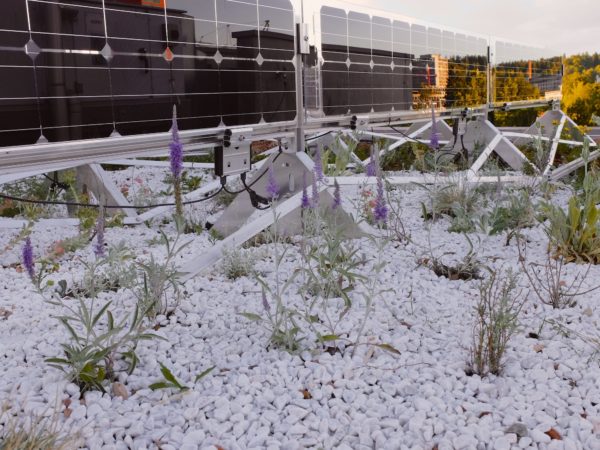House owners with flat roofs have been spoilt for choice between greening the unused area to cool the house, or producing electricity via a PV rooftop system. A combination of the two had for long seemed too difficult because the area was often too small and any plant growth could have shaded the solar modules in the long run.
Swiss Association Solarspar has now taken a first step, together with researchers from the Zurich University of Applied Sciences (ZHAW), towards solving this conundrum. As part of a pilot project, the team has developed a system that is lined up to provide new insights for the best use of planted rooftop areas in connection with solar systems, the Swiss association announced on Tuesday.
 Since 2012, Solarspar and the ZHAW have been looking for new methods to combine solar systems with green rooftop areas. On a test facility, researchers have discovered that a planting below the modules does not have a significant cooling effect, the association from Sissach explained. However, the evaluation of beetle traps has shown a positive impact on biodiversity.
Since 2012, Solarspar and the ZHAW have been looking for new methods to combine solar systems with green rooftop areas. On a test facility, researchers have discovered that a planting below the modules does not have a significant cooling effect, the association from Sissach explained. However, the evaluation of beetle traps has shown a positive impact on biodiversity.
Popular content
Most important, the researchers discovered that a vertical elevation of the PV system with bifacial solar modules is well suited for planted rooftop areas. An east-west orientation/alignment of the modules allows electricity produc tion during particularly demand-intensive times of the day. According to Solarspar, silvery-gray plants such as white rock-rose and thyme encourage the reflection of sunlight, which leads to increased solar power production.
tion during particularly demand-intensive times of the day. According to Solarspar, silvery-gray plants such as white rock-rose and thyme encourage the reflection of sunlight, which leads to increased solar power production.
For the first time, the researchers have now applied their new findings on a roof atop a senior citizens' building in Switzerland. The researchers installed purpose-built small modules with 20 cells on a Zinco's substructure. Larger solar modules could have only been mounted at a wider distance due to the shading, and would have faced too much wind stress. According to Solarspar, the prototype, which is supported by €44,500 in funding from Stadtwerk Winterthur, allows extensive tests of a planted rooftop area combined with small modules under natural conditions.
This content is protected by copyright and may not be reused. If you want to cooperate with us and would like to reuse some of our content, please contact: editors@pv-magazine.com.


3 comments
By submitting this form you agree to pv magazine using your data for the purposes of publishing your comment.
Your personal data will only be disclosed or otherwise transmitted to third parties for the purposes of spam filtering or if this is necessary for technical maintenance of the website. Any other transfer to third parties will not take place unless this is justified on the basis of applicable data protection regulations or if pv magazine is legally obliged to do so.
You may revoke this consent at any time with effect for the future, in which case your personal data will be deleted immediately. Otherwise, your data will be deleted if pv magazine has processed your request or the purpose of data storage is fulfilled.
Further information on data privacy can be found in our Data Protection Policy.